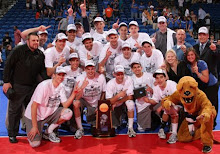Thursday, February 26, 2009
The Dreaded Patella Tendonitis
Patella Tendonitis, also known as Jumpers' Knee, is very common with volleyball players. It is usually caused by extreme stress such as repetitive jumping, which could create partial ruptures and lead to inflammation and degeneration. It is mostly the result of overuse. It can get pretty ugly here is what you need to know, hopefully to keep you from an advanced stage of the dreaded patella tendonitis.
Symptoms: Go figure, the only symptom is pain just below your knew during or after a workout, usually becoming more acute when you place direct weight on your knee while running or jumping etc.
Anatomy: Patella tendon, connecting kneecap to tibia
Treatment: *Depends on the extent of the injury. There are 4 "grades" of injury, getting progressively worse. Each one requires a little more proactive treatment.
Grade 1 ~ Characterized by pain after exercise. Continue training but apply ice after each session, wear a heat retainer/support, a sports injury specialist can use sports massage techniques
Grade 2 ~ Characterized by pain before and after exercise. Modify your training sessions (shorten them or try an exercise that puts less stress on the knee. Try swimming or biking instead of running and jumping), stop jumping, a sports injury specialist can apply sports massage techniques and give you uniques exercises for rehab.
Grade 3 ~ Characterized by pain before, during, and after exercise. Rest completely from aggravating activity, a sports injury specialist can use sports massage techniques and give you a complete rehab program.
Grade 4 ~ Characterized by constant pain even during everyday activities. Rest (for at least 3 months!), a sports injury specialist can still use sports massage techniques and get you a rehab program, as well as prescribe medication, use ultrasound/laser treatment, use cross friction massage techniques. If need does not respond adequately to these treatments, you need to see an orthopedic surgeon who could operate.
Surgery ~ techniques include detachment of the patella tendon from the inferior pole, excision of the degenerative nodule, drilling, or excision of the inferior pole
~Successful 60%-90%
~patient must usually wear a straight brace for 2-4 weeks
~Risks include infection (as with all surgeries), stiffness of the knee, suture reaction, failure of satisfactory healing, all normal risks of anesthesia, phlebitis (inflammation of a vein), pulmonary embolus (blood clot in the lungs), and persistent pain or weakness even after surgery and repair.
Prevention: Strengthen legs and keep muscles balances so that your upper leg muscles aren't pulling harding on your tendon than your lower leg muscles, stretch, and give your body enough recovery time between workouts, practices, games, etc.
Subscribe to:
Post Comments (Atom)



No comments:
Post a Comment